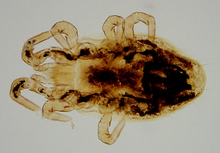Quick facts
- Bird mites are parasites of poultry and wild birds.
- Some situations can bring bird mites into contact with people.
- Although small, bird mites are visible.
- Bird mites can bite people but cannot reproduce on human blood.
Identifying bird mites
- Like all adult mites, they have two main body parts and eight legs.
- They are very small (about 1/32 inch long), but are visible with the naked eye.
- They can vary in color but are generally brownish or grayish. They can appear darker after feeding.
They are associated with bird nests on or in buildings.
Northern fowl mite. Photo: Blaine Mathison
Bird mites and other types of mites found in homes can be difficult to distinguish from each other because of the tiny characters that need to be seen for identification. Correct identification is necessary for effective control.
Contact a specialist if you need help identifying mites seen in your home.
Biology of bird mites
The most common bird mites are northern fowl mites (Ornithonyssus sylviarum) and chicken mites (Dermanyssus gallinae).
Bird mites live on a wide variety of domestic and wild birds, including poultry, pigeons, starlings, sparrows and robins.
- These mites normally remain on birds or in bird nests throughout their lives.
- Mite eggs are laid in nests or on feathers.
- They hatch in two to three days and adults are seen about five days later if birds are present.
Bird mites can also be accidentally introduced into homes through pet birds, like parrots or canaries.
If a bird falls out of a nest and dies or a nest is abandoned, bird mites look for other hosts.
- These mites may enter homes to search for food when nests are on or in buildings.
- Bird mites are active during the summer.
Bird mites can bite people as they search for hosts, but they cannot reproduce on human blood.
- Northern fowl mites and chicken mite can survive for about two weeks without a bird blood meal.
- Without a bird blood meal, they will die.
Importance of bird mites
When bird mites cannot feed on birds, they will search for new hosts. This can lead them into homes and other buildings.
They can bite people but fortunately they are not able to reproduce on human blood.
- These bites generally are annoying, although the reaction by people can vary and it may be more painful for some.
- Bird mites have not been found to transmit any diseases to people.
- Because they cannot reproduce on human blood, birds mites cannot create an ongoing infestation in a home.
How to get rid of bird mites
Physical removal is the best control when bird mites are found in homes.
- Vacuum them or wipe them up with a moist cloth.
- Vacuuming does not kill the mites. Freeze or throw away the vacuum cleaner bag to prevent the mites from crawling back out.
There are several steps to prevent bird mites from entering a home.
- Remove any dead birds that you find. Remove and dispose of empty nests.
- Do not disturb nests if eggs or young birds of federally protected songbirds are present.
- If the nesting season is over and only adults remain, you may remove the nest without harming the birds.
- Pigeons, starlings and house sparrows are not federally protected. You may remove their nests any time.
An insecticide application around the outside, especially around windows, doors and other possible entry points, helps keep bird mites out of a home.
- Effective insecticides include: permethrin, ß-cyfluthrin, or deltamethrin.
- Another option is to hire a professional pest management service to treat your home.
CAUTION: Read all product directions very carefully before buying pesticides and again before applying. If you cannot treat an outside area without harming an occupied nest, do not spray. Leave the nest alone until it is abandoned; then you can spray the house if mites are still a problem.
Reviewed in 2020


